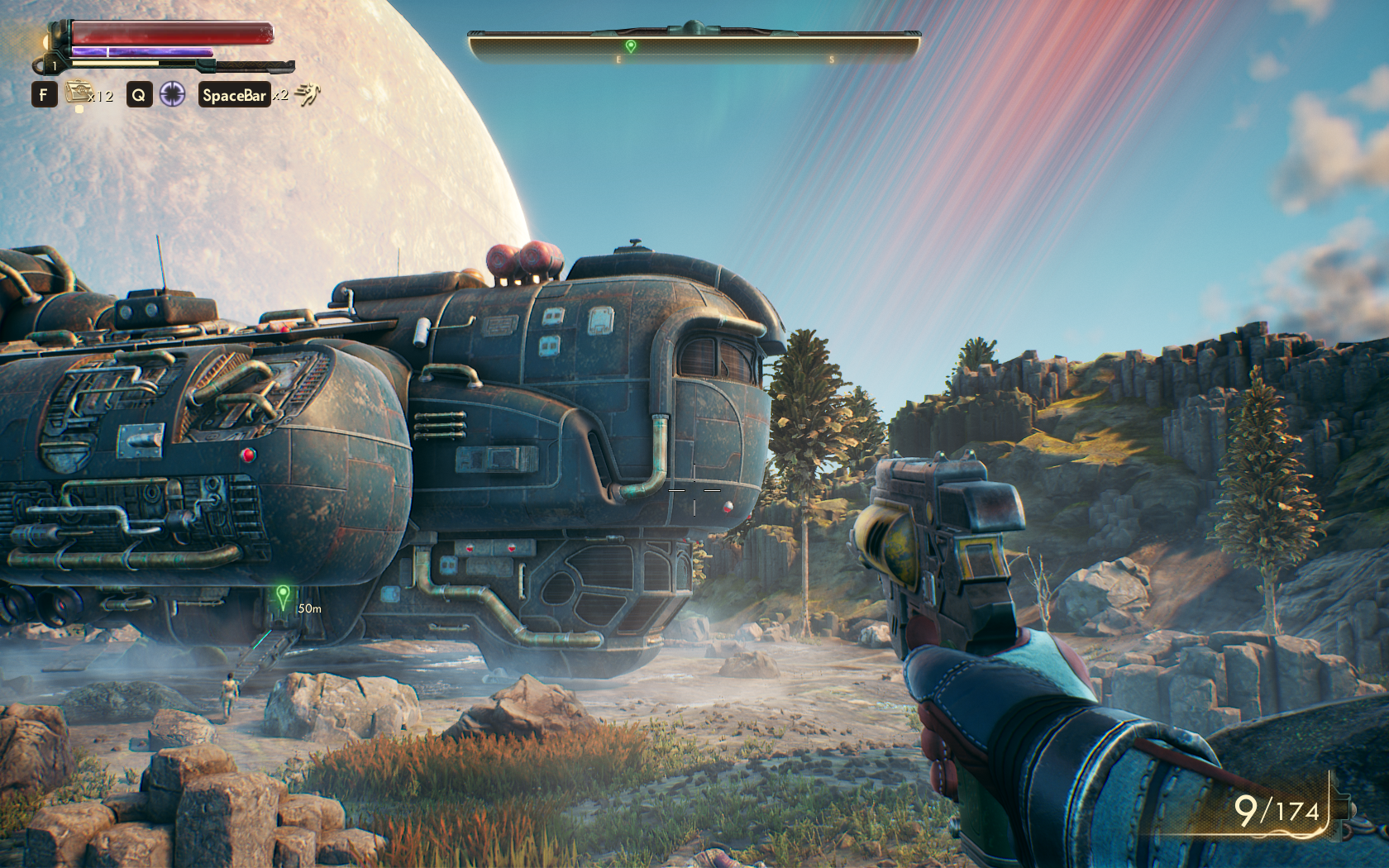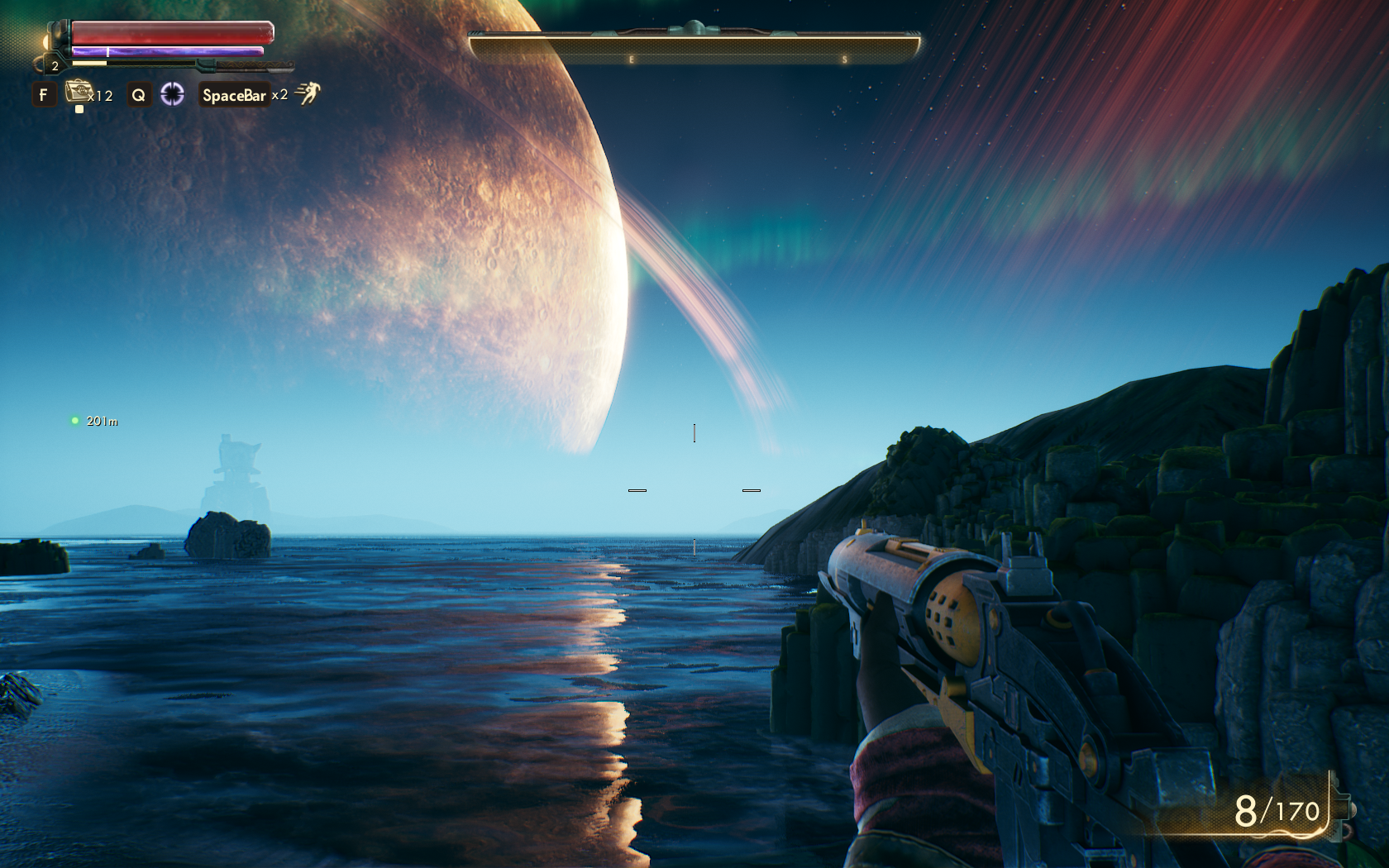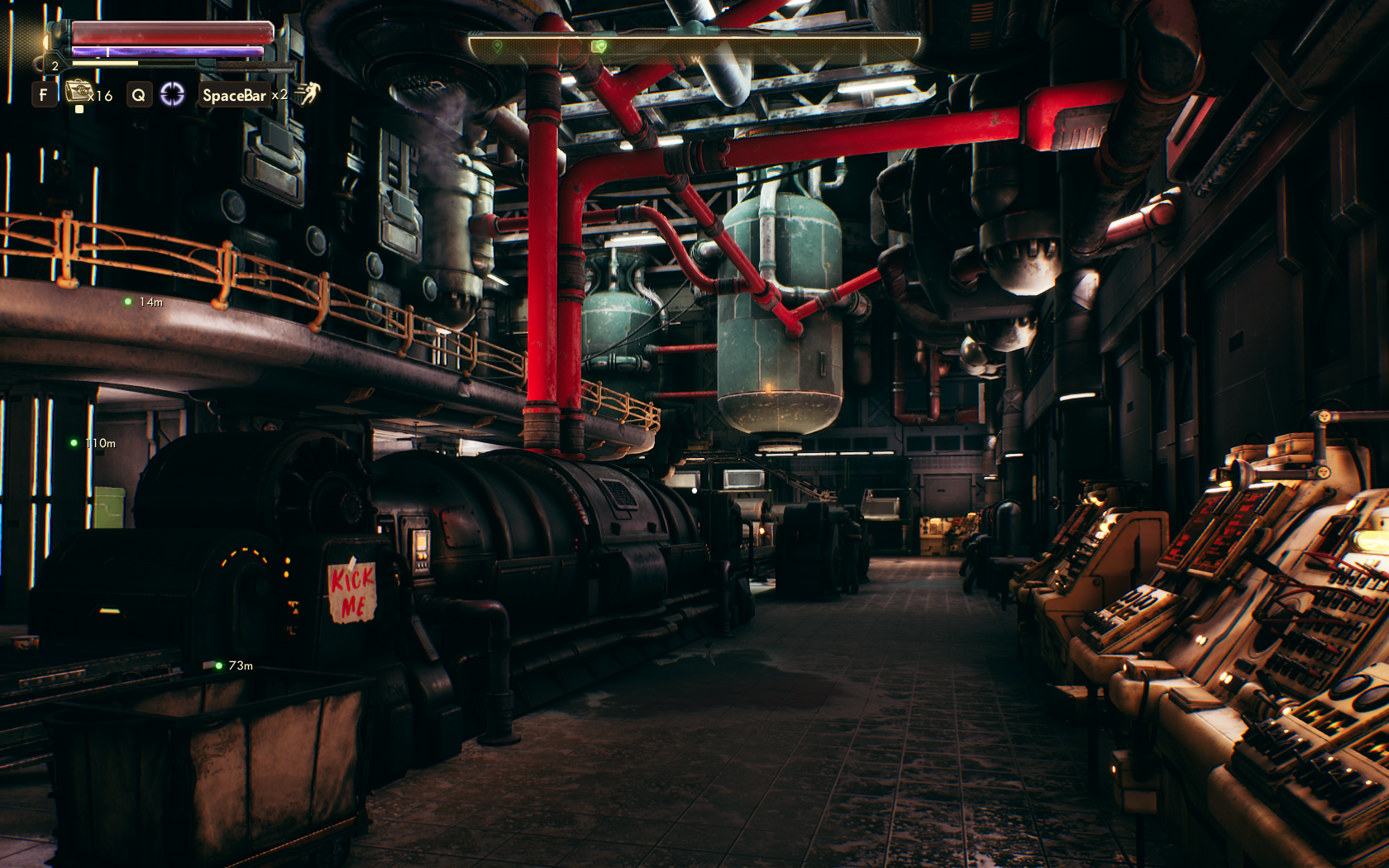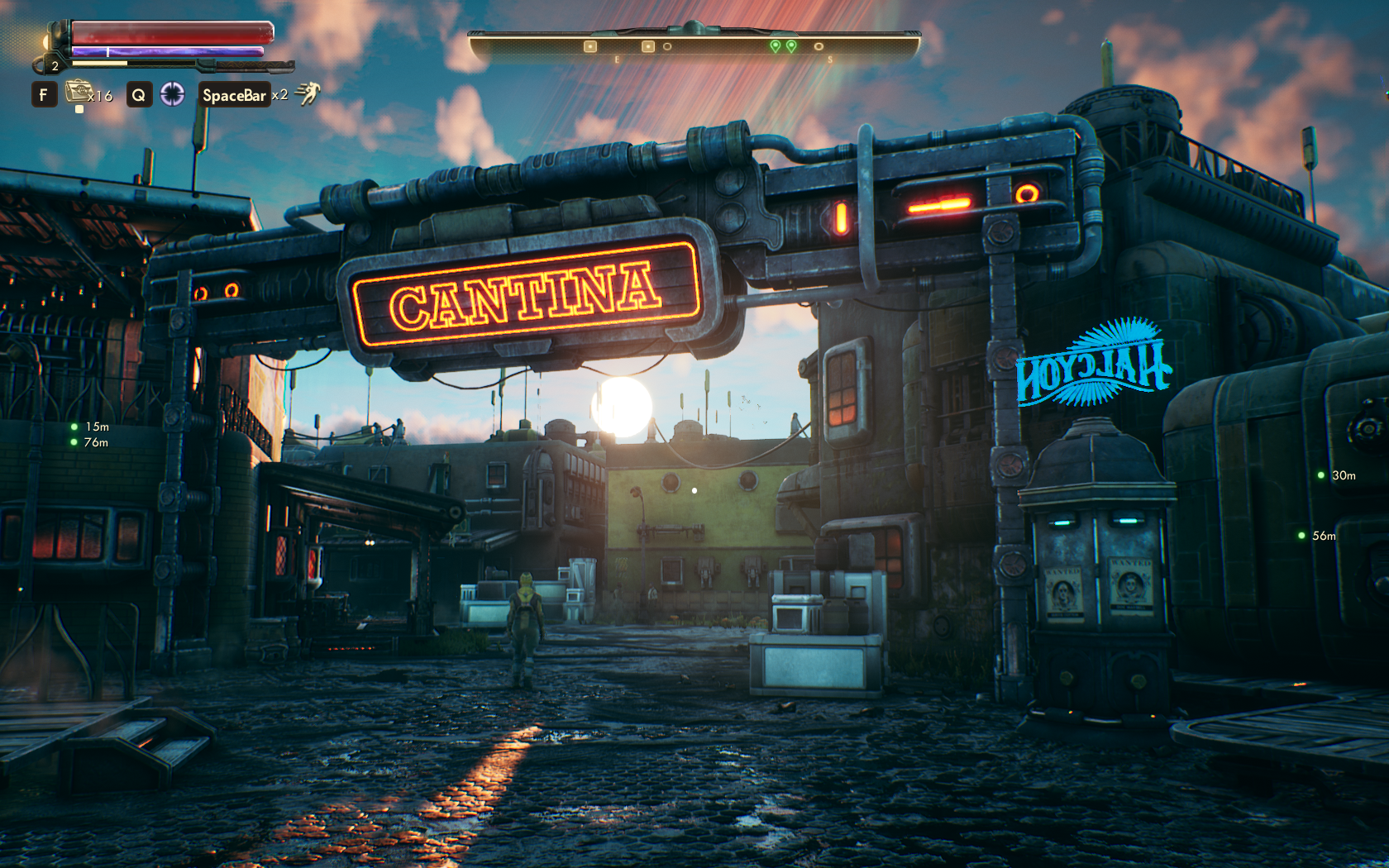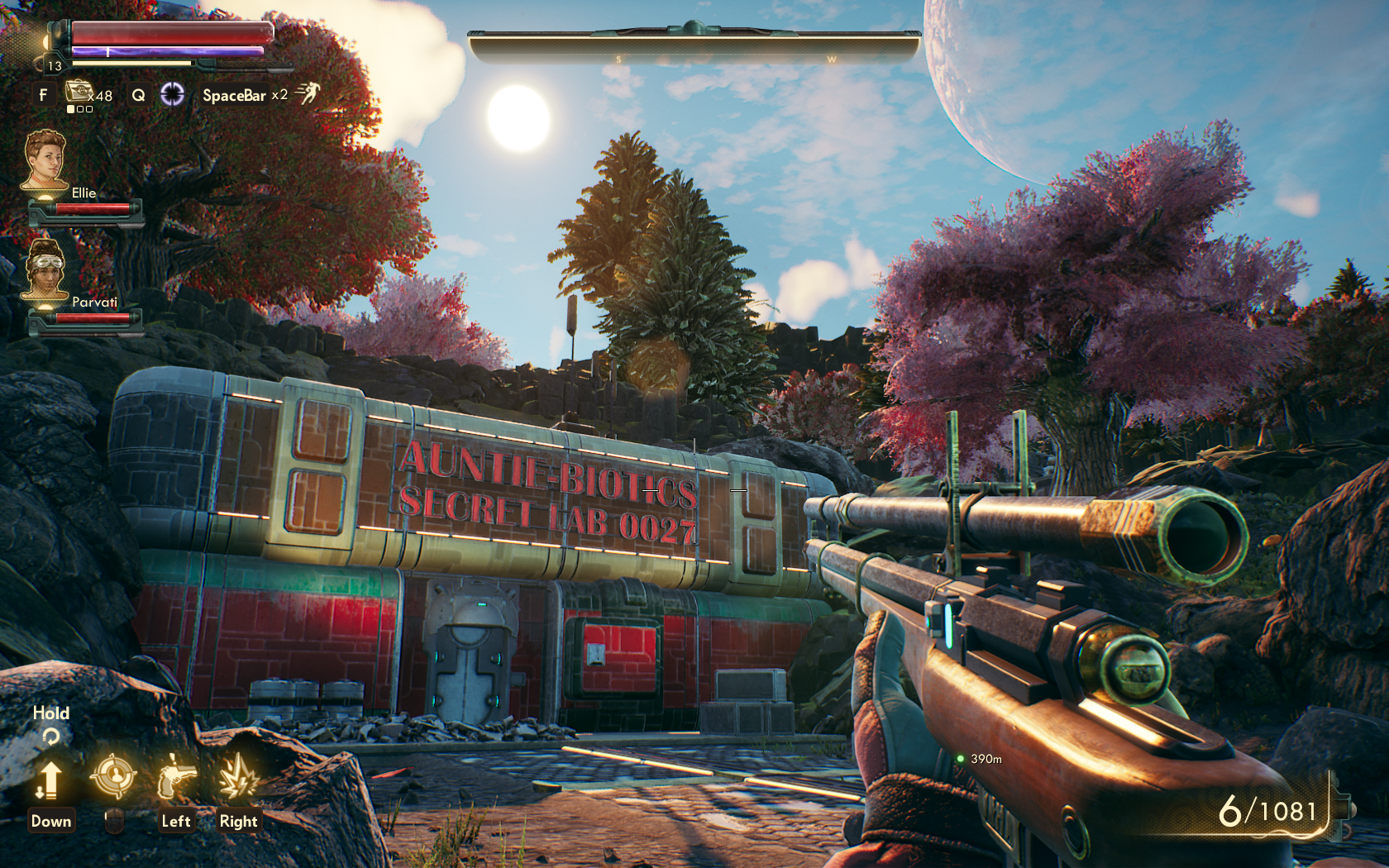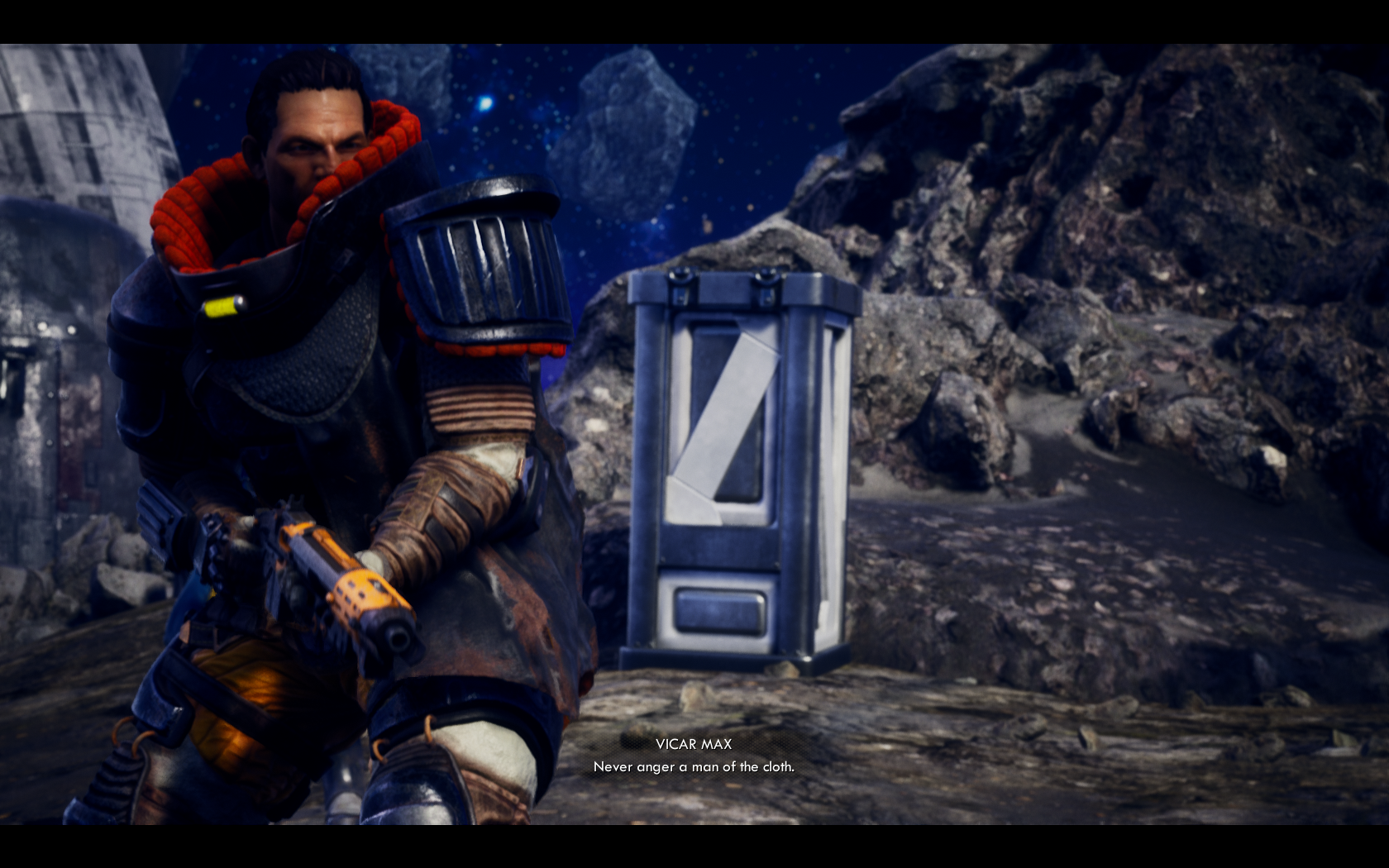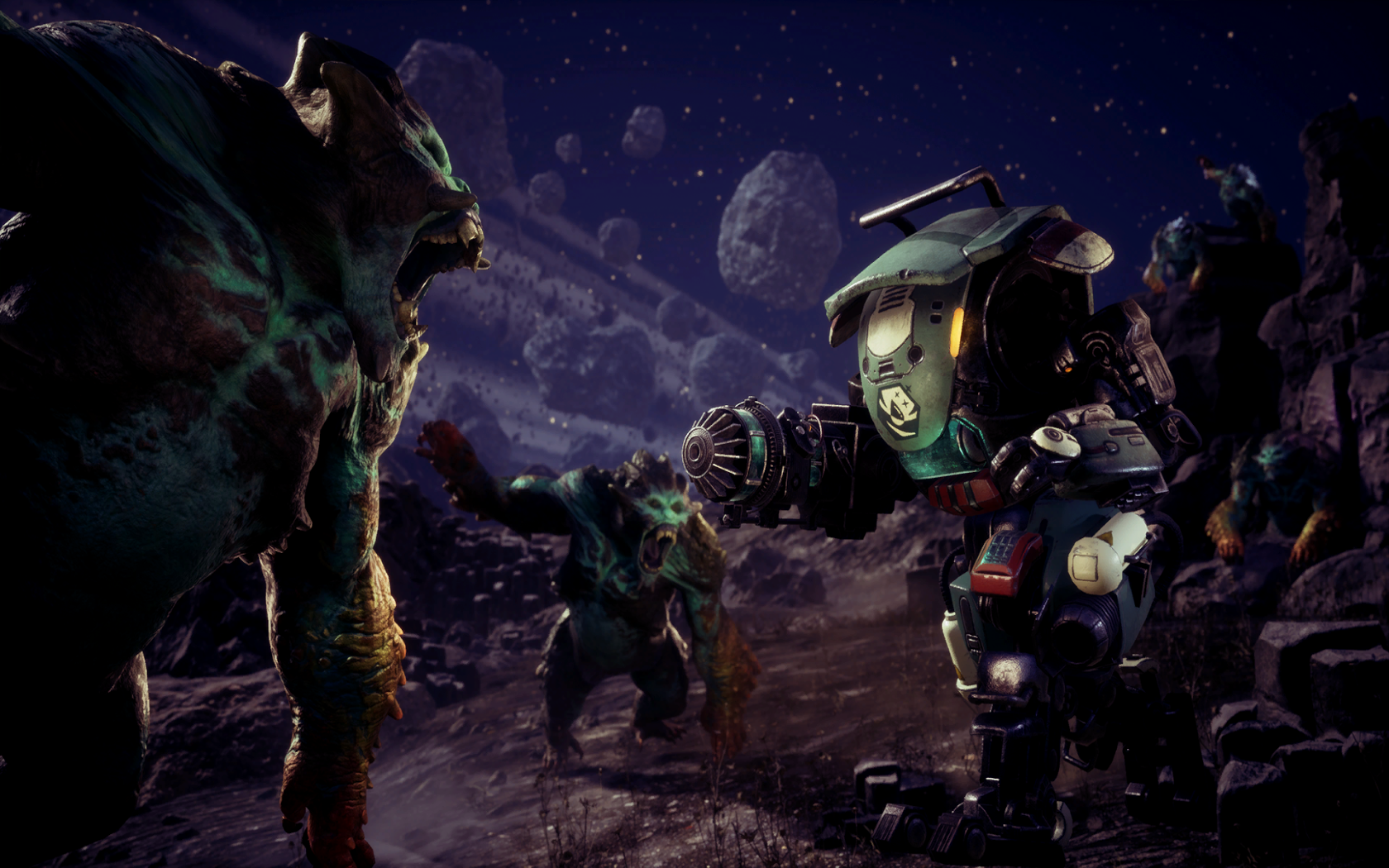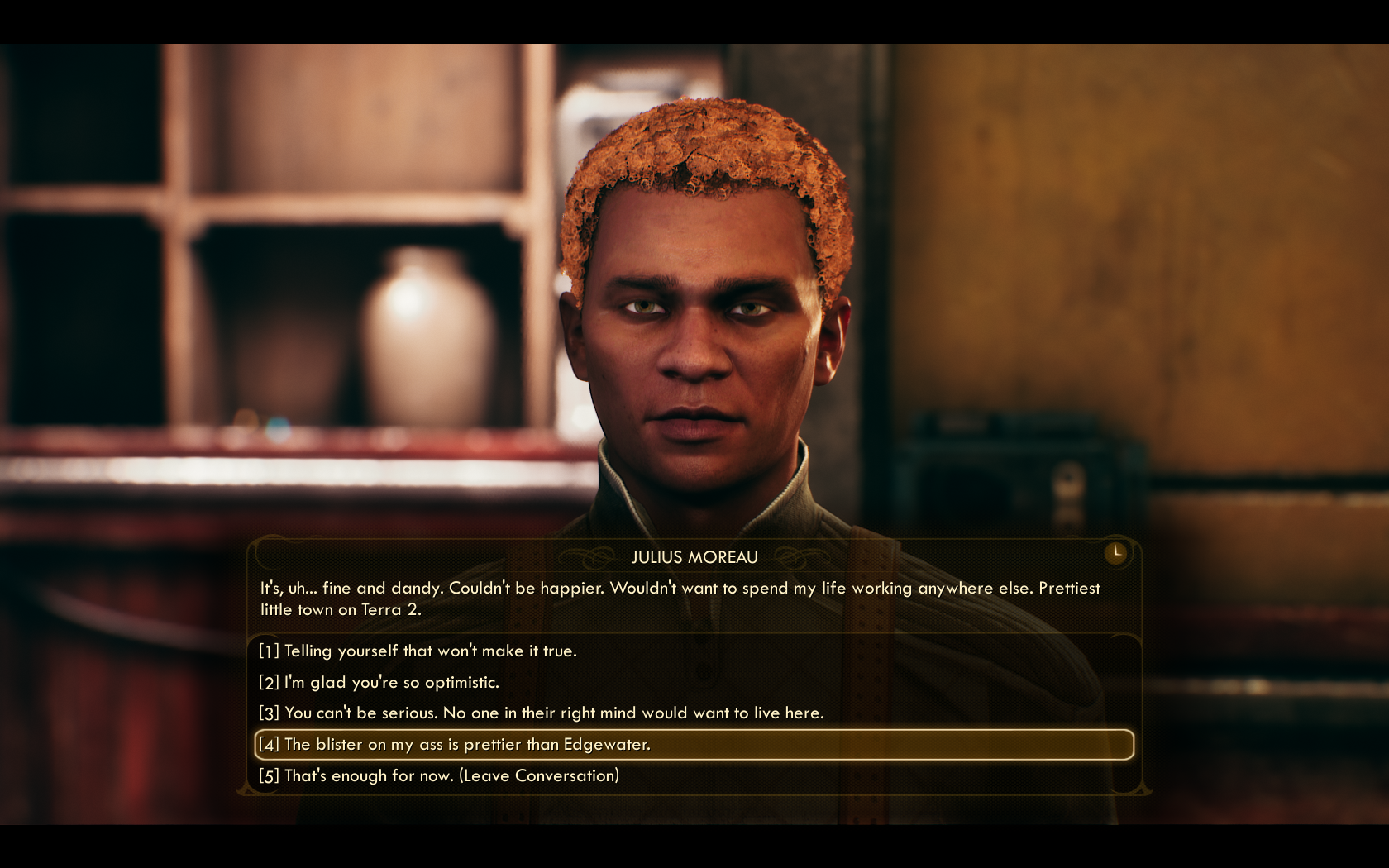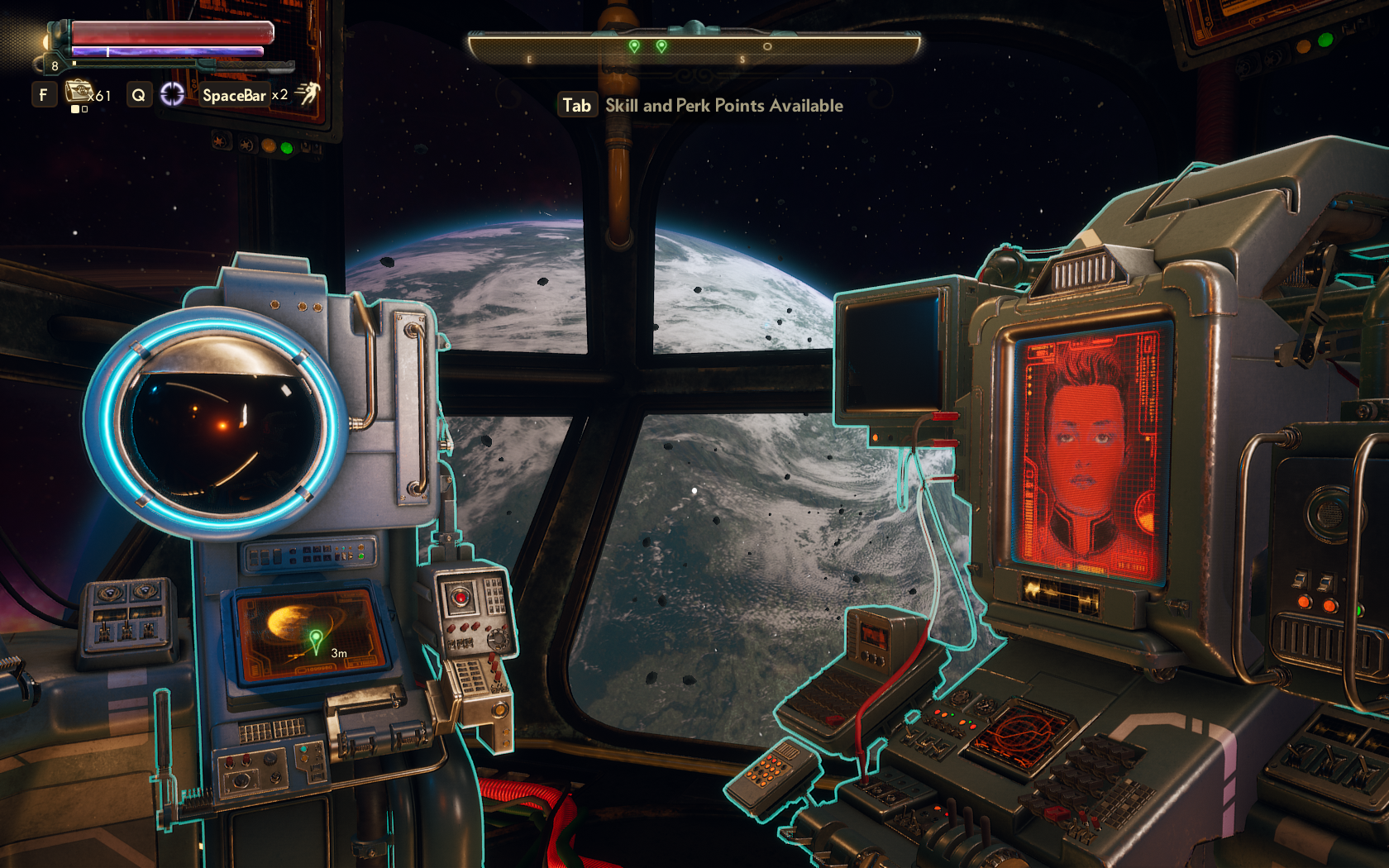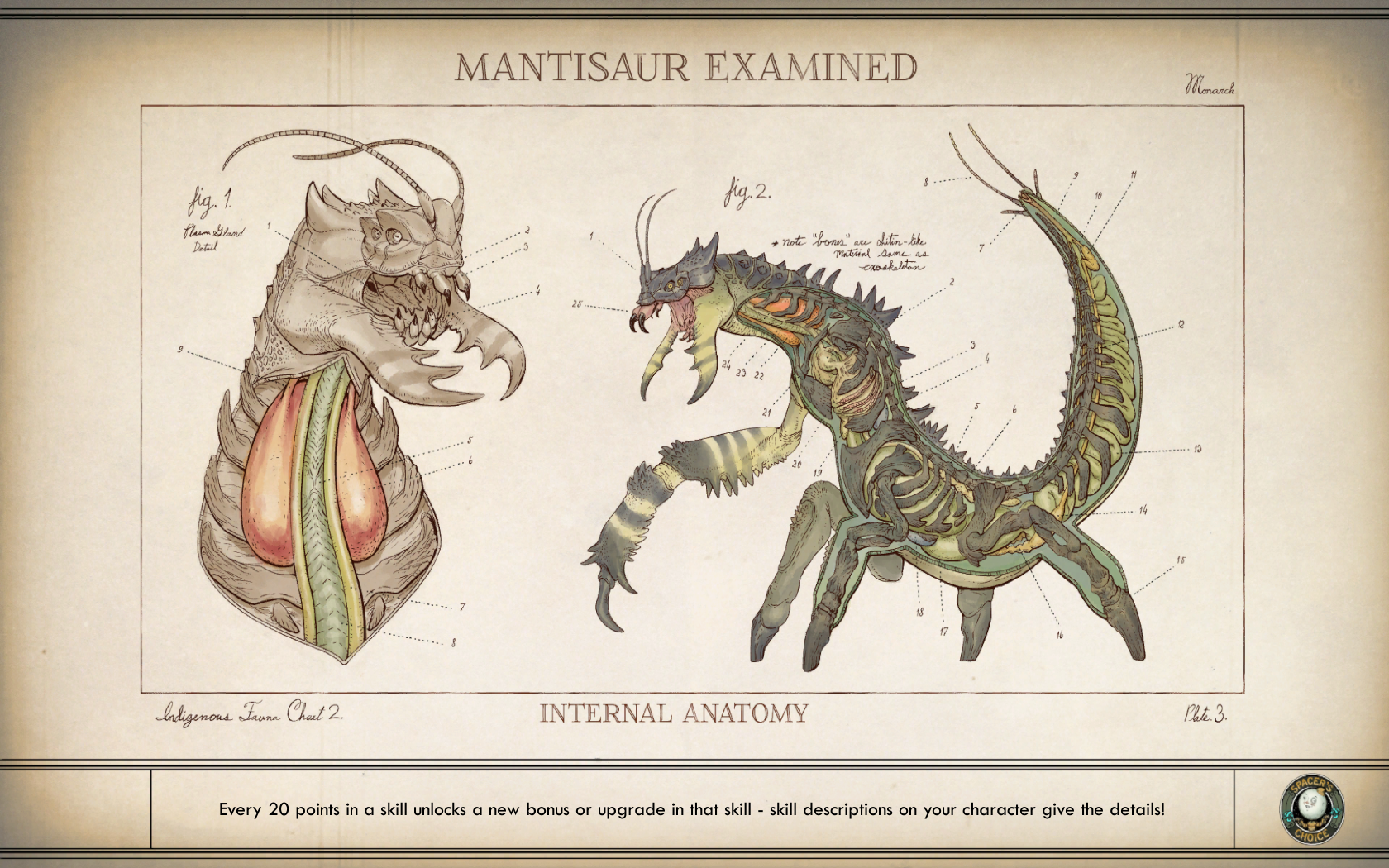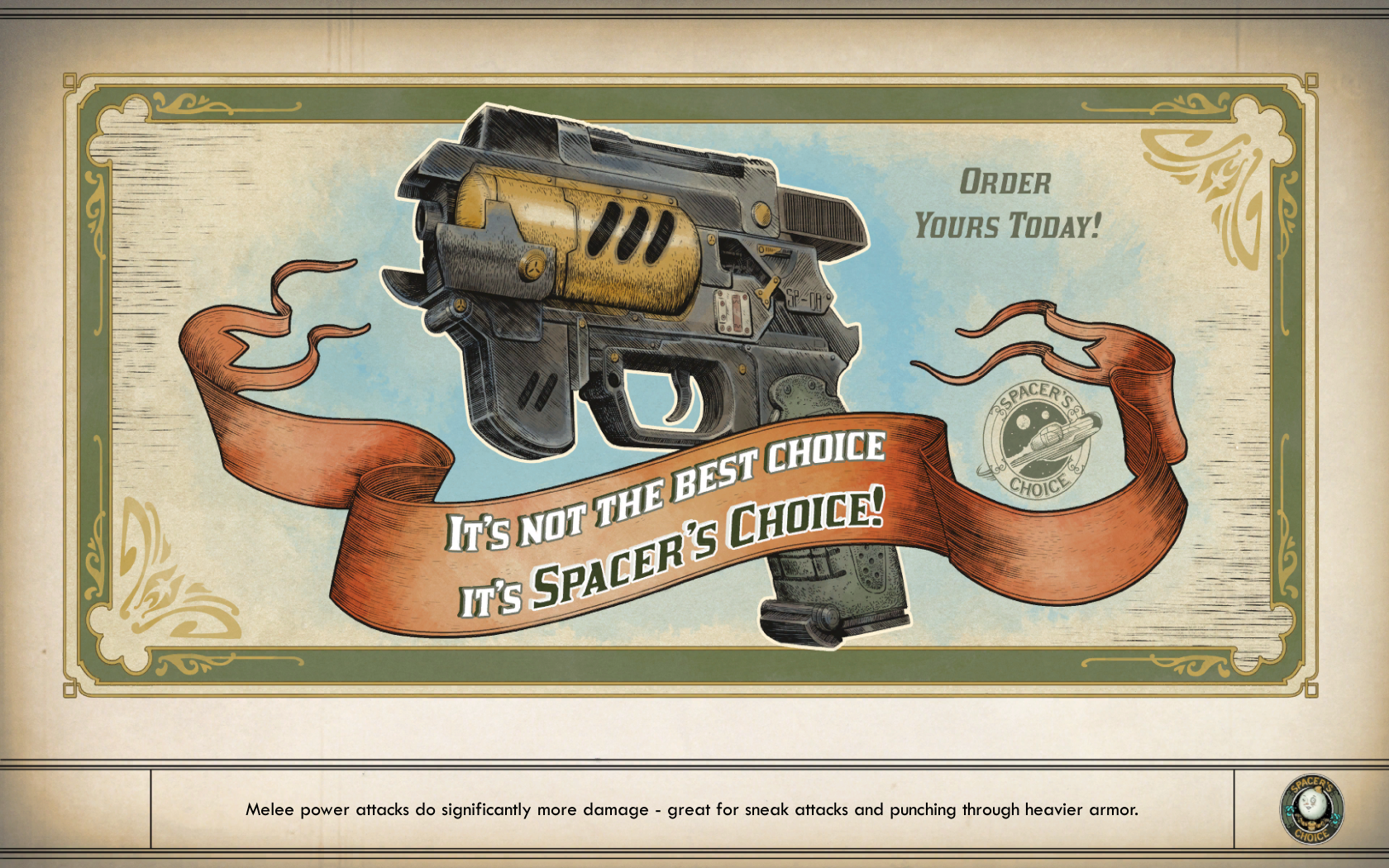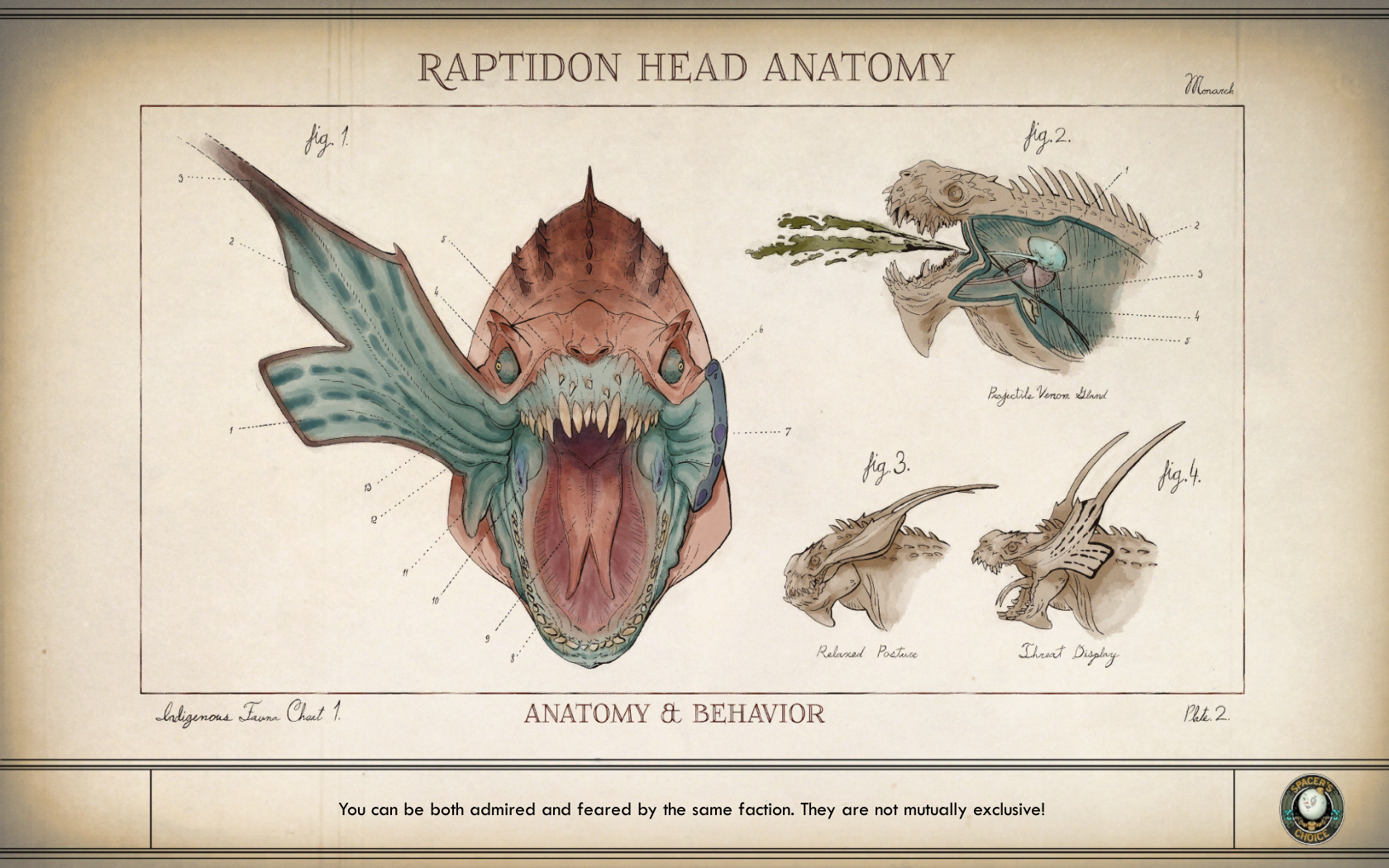Over the last twelve months, we have watched as a singular disastrous game launch has scuttled one of the most beloved game developers in recent times. I say scuttled because most of the misfortune that has been heaped upon this once bright studio, seems to have been self-inflicted. Not content with releasing an utterly broken game, they went on to commit multiple own goals in the form of product disasters like the canvas bag debacle and also inadvertently doxing customers who were seeking a refund. I am of course talking about Bethesda and the now infamous Fallout 76, but why?
Well this week I have been playing The Outer Worlds, a game from Obsidian Entertainment which is inextricably linked to the world of Fallout. In 2010 Obsidian released Fallout: New Vegas and while it scored well with critics it went on to become a revered classic in the eyes of Fallout fans. The game famously missed a score of 85% of Metacritic by one point and so Bethesda refused to pay out a bonus, which had many adverse effects. Obviously, people fall on different sides of the debate but I personally think it was penurious to not reward Obsidian in some way for what was clearly one of the best Fallout games ever made. The developers over at Obsidian have been very clear, they do not wish their game to be used as a stick to bash Bethesda and I agree with this noble sentiment. Never the less, it is somewhat ironic that many now see Obsidians new game to the Fallout everyone has been waiting for.
Hop, Skip and Jump
The game starts with you being woken from a long stint in suspended animation, one that would give Ellen Ripely a run for her money. You and thousands of other colonists had set off from earth seventy years ago, bound for the Halcyon System on what should have been a decade long sleep. For reasons unknown the skip drive on your ship (the Hope) malfunctioned and the vessel was assumed lost. The scientist who has restored you explains he needs your help in waking the other folk still slumbering on the Hope and so your main quest begins in earnest.
It is at the point of being thawed out that you get to make some fundamental choices about your character. All the usual options are here from gender, face/hair choices and various stat-based characteristics. There is a way to add your previous employment but unfortunately after the initial stat boost this didn’t seem to factor into the gameplay at all. After some playing around I was able to cobble together a character I was happy with and was then unceremoniously launched into space. As your drop pod lands planet side you discover that your contact was, unfortunately, the reason you had such a soft landing. As you leave your drop pod the view of Terra 2 pans out in front of you and atmospherically this is a very good first impression indeed. After a few brief tutorial esque situations, you come across your contacts old ship which is now missing a captain. The A.I onboard your new ride, the Unreliable, seems all too happy to give you the pink slips and so very quickly you acquire the means to travel to other planets, maybe.
As you play you will gain experience for combat and quests alike, which then in turn level you up. Every time you level up you can collectively increase a whole section of your stats. So for example when you increase Stealth this will put a point into Sneak, Hack and Lockpick. Then once you reach level 50, each of these sub-skills will be raised independently, forcing you to specialise. In addition, every even level you gain a perk point which will let you unlock some useful (if a little generic) skills. These can be anything from running speed, increased weight capacity and a boost to your time slowing ability.
One gameplay feature I thought I would get on with was the flaws system because I like the idea of your adventures leaving their mark on you. Occasionally you will be presented with the opinion to take on a flaw, usually it’s contextual so falling a great height too many times might get you a fear of heights or being murdered by robots will make you weaker against them. If you do take a flaw you gain a perk point which sounds great, the only downside is that you take a fairly big thump to your stats. I would far rather have had an actual effect from these flaws, like a visible limp for fall damage or a missing hand from a large plasma hit.
Edge of the World
Your first task is to acquire a power source for your newly acquired spaceship and maybe a few crew members to occupy its living quarters. My first impressions of the gameplay were a mixed bag if I am honest. Anyone who knows me will know I love exploring the water in games and so on seeing the beach I was like a Brit on the first day of summer. Running headlong into the ocean I was imagining the secrets that would be found below the waves and boom, invisible wall. Feeling a bit put out about this I decided to let the game lead for a while and which takes me to my next issue on traversal. Walking across the scenery in Outer Worlds feels like driving a shopping trolley across a landfill site. On the open ground, it’s good going but once you try and scale some rocks or even a small hill the wheel comes off. This seems strange to me because there are hidden secrets here and there which need a precise jump to reach.
Before reaching the main town of Edge Water you come across a camp of marauders and so I decided to test out the stealth gameplay. Happy to see tall grass does conceal your presence I envision myself becoming a silent assassin, picking off the hapless enemies one by one and.. wait there’s no takedown ability? Undaunted I twat my mark on the head but unfortunately, this hefty clout doesn’t kill him outright; understandably he’s not too happy with me. A messy gunfight ensues and as I stand on a pile of smoking bodies I wonder, when will this game let me do something I want to do?
Personality goes a long Way
Ok so yes, in my opening I’ve been pretty harsh on The Outer Worlds but bear with me. After I did make it to the city on Edgewater I was finally able to see why people had been raving about the games dialogue structure. After making my way around the town I picked up a decent amount of quests and had established my main goal for the area. A few hours later I had polished off most of the side quests on offer and was ready to reach the area finale. Like all good RPGs, there is a choice to be made and for most of the build-up I knew what I was going to do. However, right at the last second one of my new companions threw her opinion on the table and it really made me second guess my decision: this is when I really started enjoying The Outer Worlds.
As you play the game you will be able to pick up various companions that will join your crew. This motley bunch of characters are one of my favourite parts of the game. Each one has their own strengths and weakness, a unique special attack and an archetype that will boost your own stats. My favourite companion was Parvati who is an engineer by trade and comes with confidence issues. If you have her in your party she can help you with engineering skill checks which means you can then focus on other skill sets. In an early conversation, I was talking with another soon to be companion and the reverend started talking with Parvarti as well as to me. This could have been intrusive but the way it has been worked into the conversions is perfect. This free-flowing conversation system runs across the entire game makes talking to NPC’s all the more interesting. When talking to NPCs we still have that static face on view where the background gets blurred but with a definite improvement in facial animation and lip-syncing, I do feel the aesthetics here beat any Fallout game.
Your various companions are also able to gain new perks when you yourself hit a certain threshold. These are as basic as they come but it’s nice to feel they are progressing with you. As you gain new weapons and armour these can also be given to your new friends to increase their damage and survivability. When back on the ship you can see them getting up to all kinds of activities from reading in their room, chatting in the canteen or even doing sexual favours for the ships horny A.I.
Connective Tissue
It is clear that the creators of The Outer Worlds know how to make a good RPG, which is to be expected considering Tim Cain and Leonard Boyarsky have served as directors on the project. These two industry veterans are actually the creators of Fallout no less and this fact alone invites comparison between the two games. The many characters you come across and the way they mesh together is one of the games greatest strengths. However, I still think that there are elements of the gameplay loop which do let the experience down significantly.
When I look at the games overall structure and level design there is something that doesn’t quite gel with me. In the 1950s the American government would build fake towns (known as Doom towns) out in the Nevada desert to test the effects of a nuclear blast. When walking around the many game hubs in The Outer Worlds it feels like I’m in one of these towns. This could be because the developers have not gone for a fully open world and instead opted for smaller more contained spaces. There are a good few locations to visit as you make your way through the game from asteroids being terraformed to maximum security prisons. One of my favourites was certainly the Ground Breaker, a large spacefaring community that has been built on a retrofitted colony ship. As you enter the main concourse it is hard not to be impressed by the excellent visuals. I will say that I wasn’t a big fan of the games colour pallet, which on some worlds like Monarch can look garish and oversaturated.
There is a day and night cycle at play here which does look great but with no weather effects as such this adds to the feeling of being on an old movie set. In addition, there is almost no wildlife other than the tiny sprats and a limited assortment of hostile creatures. I remember having this feeling when playing Metal Gear Solid 5, that the enemy camps were amazing fun but the connecting space around them felt devoid of life. I totally understand that this is not a AAA game and this has to be taken into consideration.
Unfortunately, the combat doesn’t seem very well fleshed out to me and this is a shame considering how much there is. Every combat situation you end up in is a case of shooting them before they shoot you. Enemies don’t flank you, search for cover, work together or do anything other than attack. The same can be said for your companions who will simply follow the combat settings you have assigned them, ie distance, melee/range etc. The range of adversaries is also pretty lean because you effectively have marauders, indigenous critters and robots enemies a little later on. Some enemies do take more damage from certain types of attack, ie electric on robots but this is about as far as it goes. There is a nifty time manipulation skill that allows you to add some strategy to your attacks, which includes location-specific effects. This more free-flowing that V.A.T.S but doesn’t really offer anything more than the system it emulates. You have a really good selection of weapons on offer and weapons/armour can be modified to add various bonus like scopes and elemental damage. There are also a few specialised scientific weapons which are great fun to play around with such as the shrink ray. Like many other systems in the game, while it works well it doesn’t shine as bright as it could.
Path of Least Resistance
As I have covered, many of the quests in the game can have varied outcomes depending on the choices you make. If you are proficient with a certain skill will often get additional dialogue options which can have interesting outcomes. Even though these larger decisions will manifest themselves into a physical action in the world (hack this computer or steal that item), the hour to hour gameplay is not as branching as I had hoped.
So for example, in a typical Deus Ex or Dishonored level, there will be paths that are woven into the character abilities. The level design in these games promotes lateral thinking: air ducts to clamber through, maybe a chandelier to drop on a guard or a pack of animals to release. These systems then feed back into the players choice on how to deal with situations. Aside from one cool camouflage tool, there are no such abilities in Outer Worlds so this really limits what they can do with the various paths. This has therefore forced these gameplay decisions to be based mostly in dialogue trees, even if they ultimately they can end in combat. I will give the game huge credit for how it adapts to your choices with the various main characters. At the point where to meet the big boss in Edgewater you can literally blow his brains out and the game adapts perfectly, even with some additional commentary from your companion. Barring one NPC you can kill anyone in this game and that show how much work Obsidian has put into giving the player that freedom.
I was surprised by how poorly the game handles theft and detection. In most towns, you can literally walk into an occupied structure and start emptying the place, even items in front of NPCs so long as your body is behind them. There are no alarms, security cameras or any system to prevent you robbing a place blind. Even if you are caught with your hand in the cookie jar, you can just pass a dialogue choice with a 1% reduction in regulation for that faction. Also, once an item is in your pocket it’s finderers keepers because stolen items are not marked like in other RPGs. This is just one more example of how inert the game is and how it fails to present itself as a living, breathing world.
Once I’ve started a game review on one difficulty I like to stick with it, just for the sake of a consistent experience. I found the normal difficulty to be surprisingly easy, so much so that I only ever used a consumable in one fight near the end of the game. Once the campaign was complete I did try hard and even this felt very pedestrian in terms of difficulty. I then tried Supernova and boom, the game was now consistently kicking my backside. This difficulty also adds survival elements like hunger, thirst and tiredness which I always like because it gives food/drink an added purpose. Unfortunately on this setting if a companion dies they stay dead and you can only save your game on the Unreliable. These two later conditions make it just a little too hardcore, I guess I would like something in between hard and Supernova.
When playing on normal and hard I also found loot to be a real problem. I guess technically I don’t have to pick every item up in a room.. but I’m a player who cannot leave a single loose screw. After the first few hours, I did find the number of items to be picked up became an absolute ball-ache, not least because you never need most of it. Consumables are both abundant but also pointless due to the lack of challenge in combat. Ammo is also superfluous to the point that in the second half of the game I just stopped picking it up. Guns and armour fair a little better and while there are too many to pick up, at least you can either sell or break these down while out in the game world. If you do grow particularly fond of a weapon there is the option to tinker its level higher and keep it relevant to your personal level.
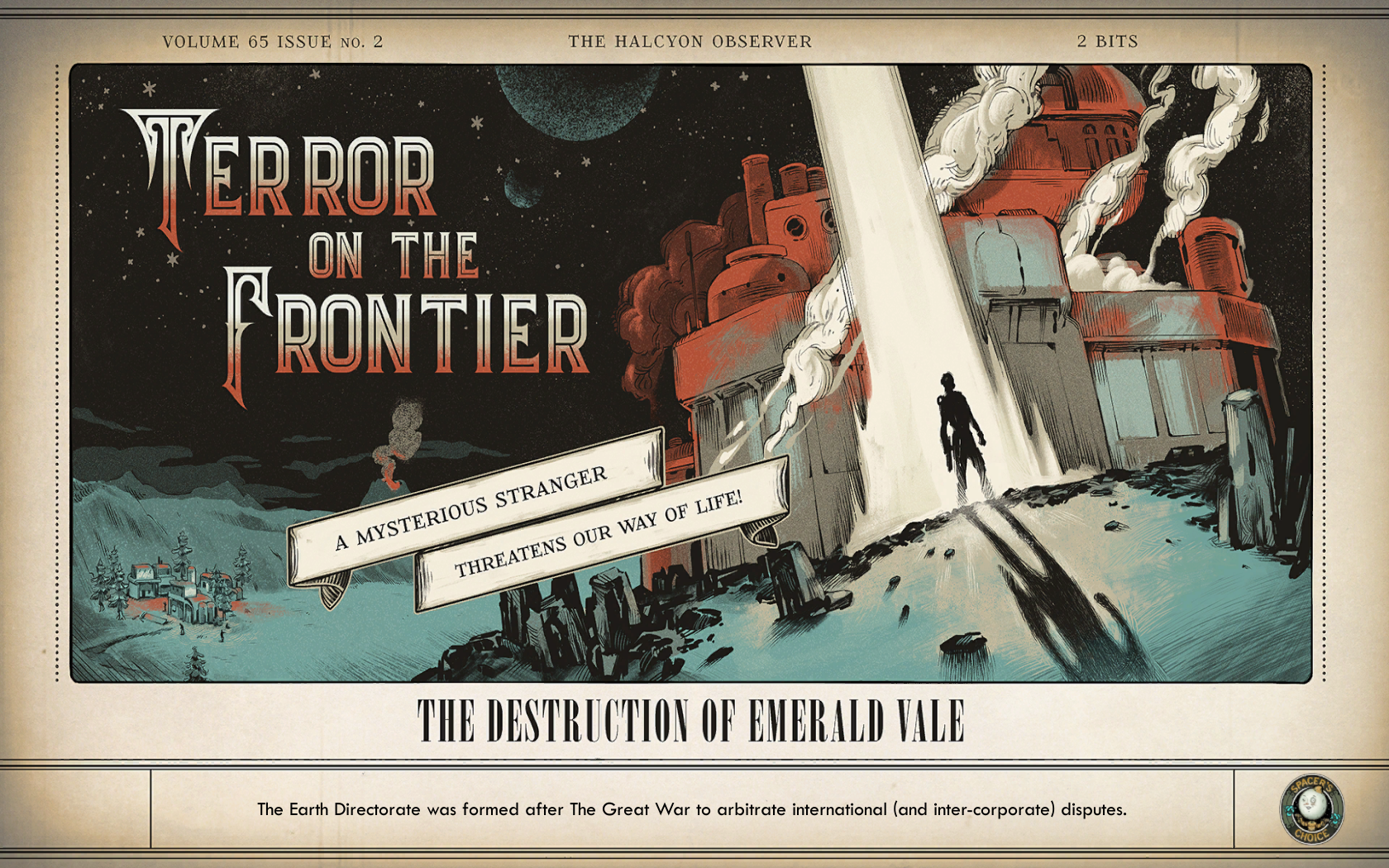
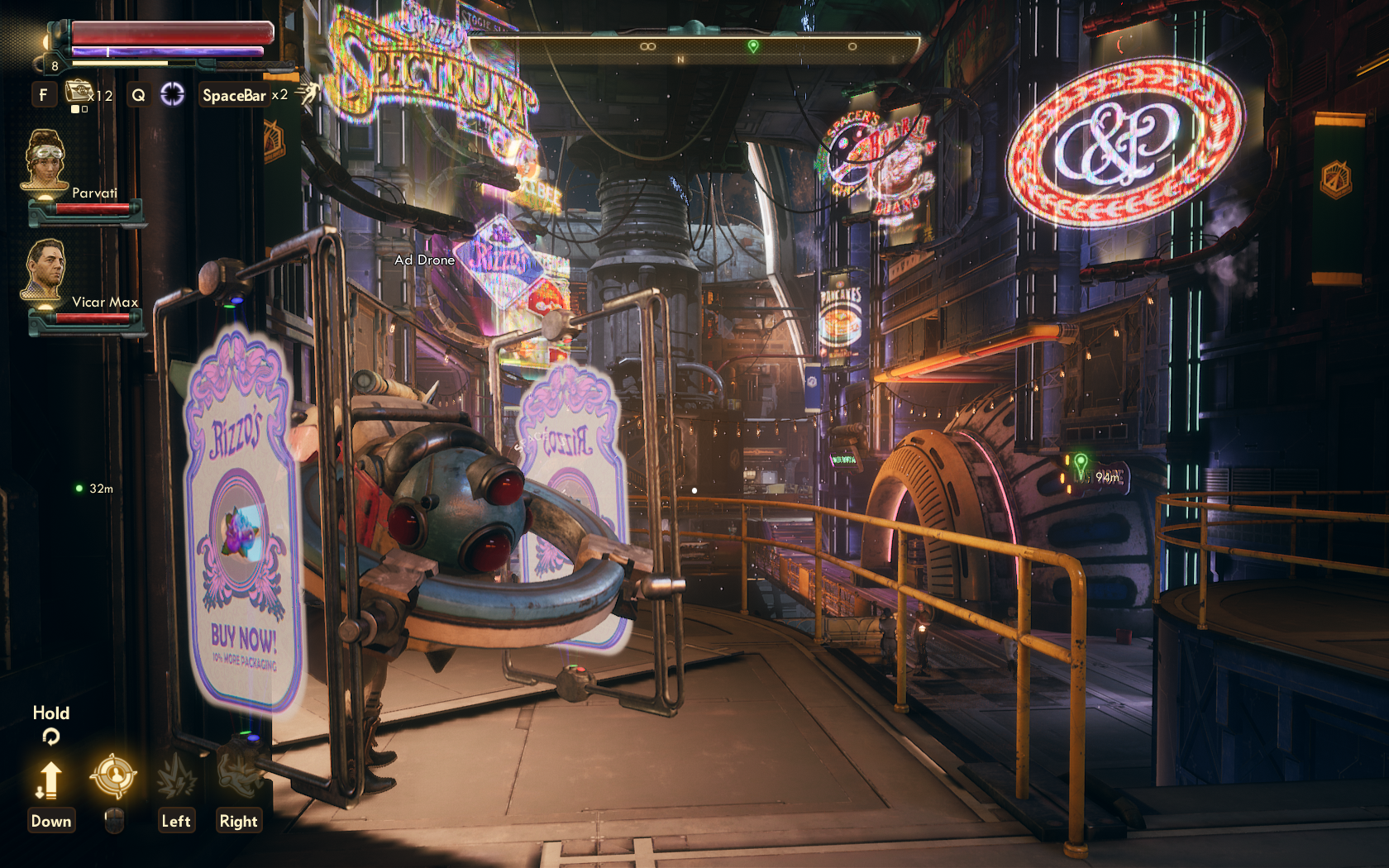
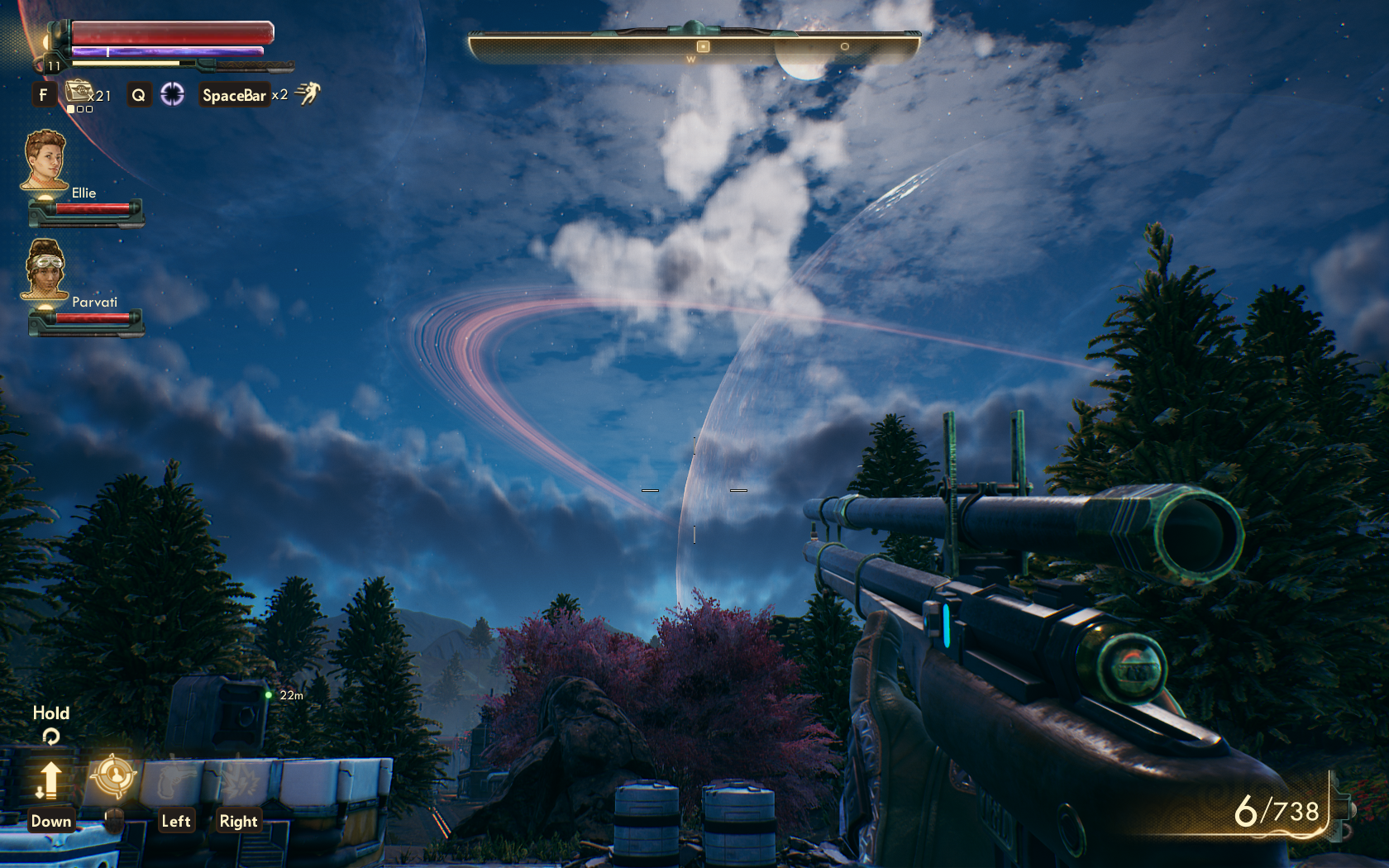
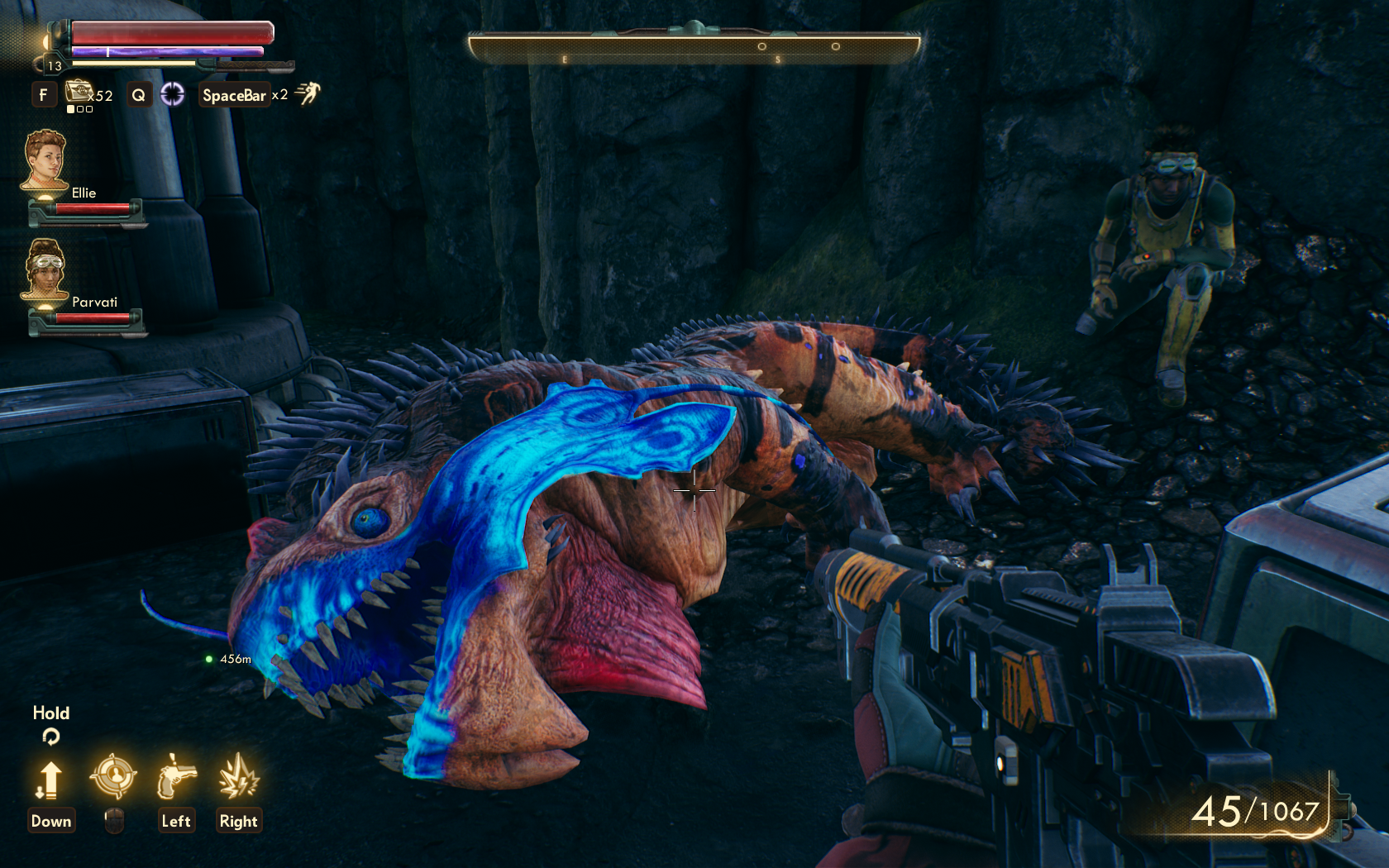
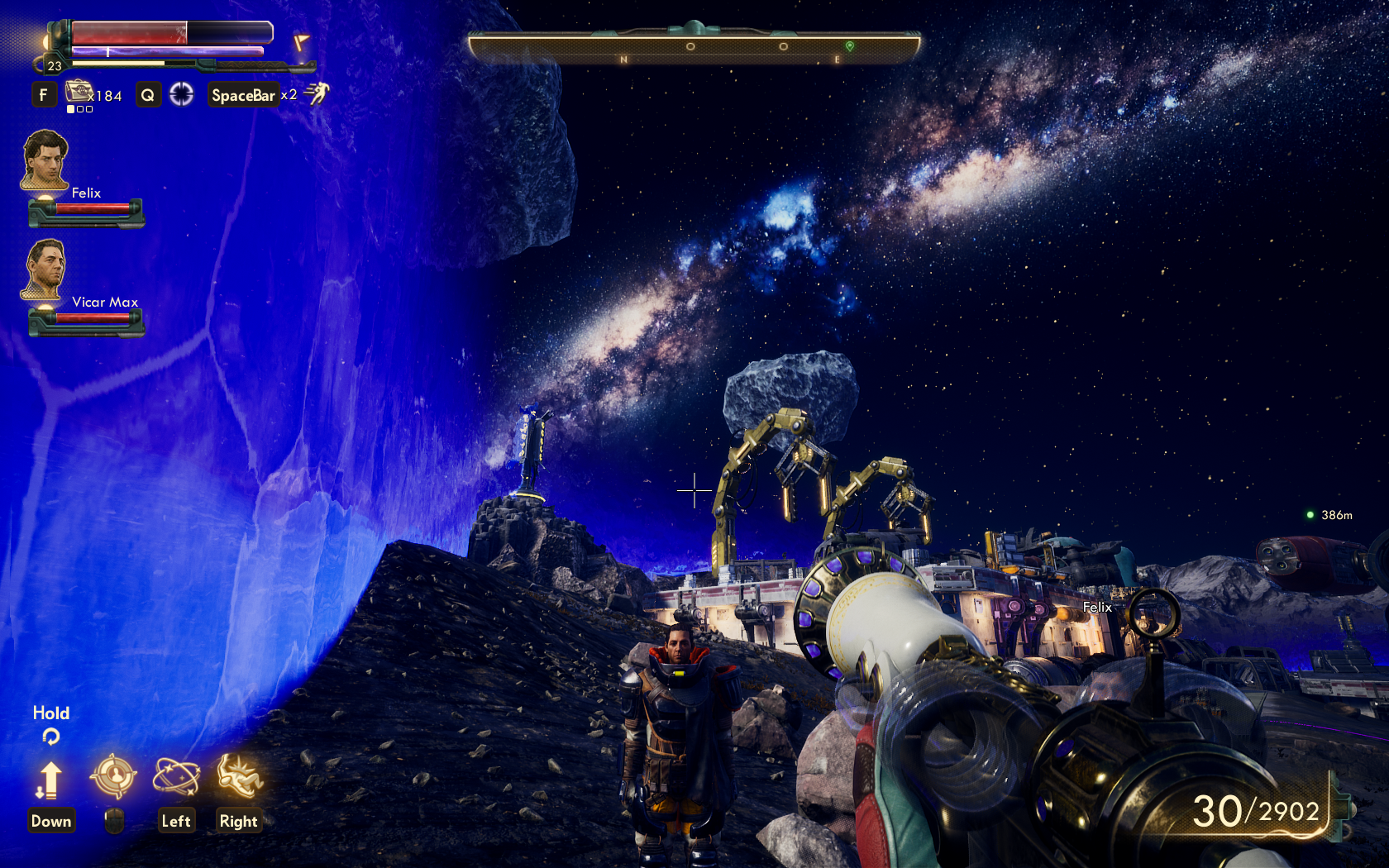
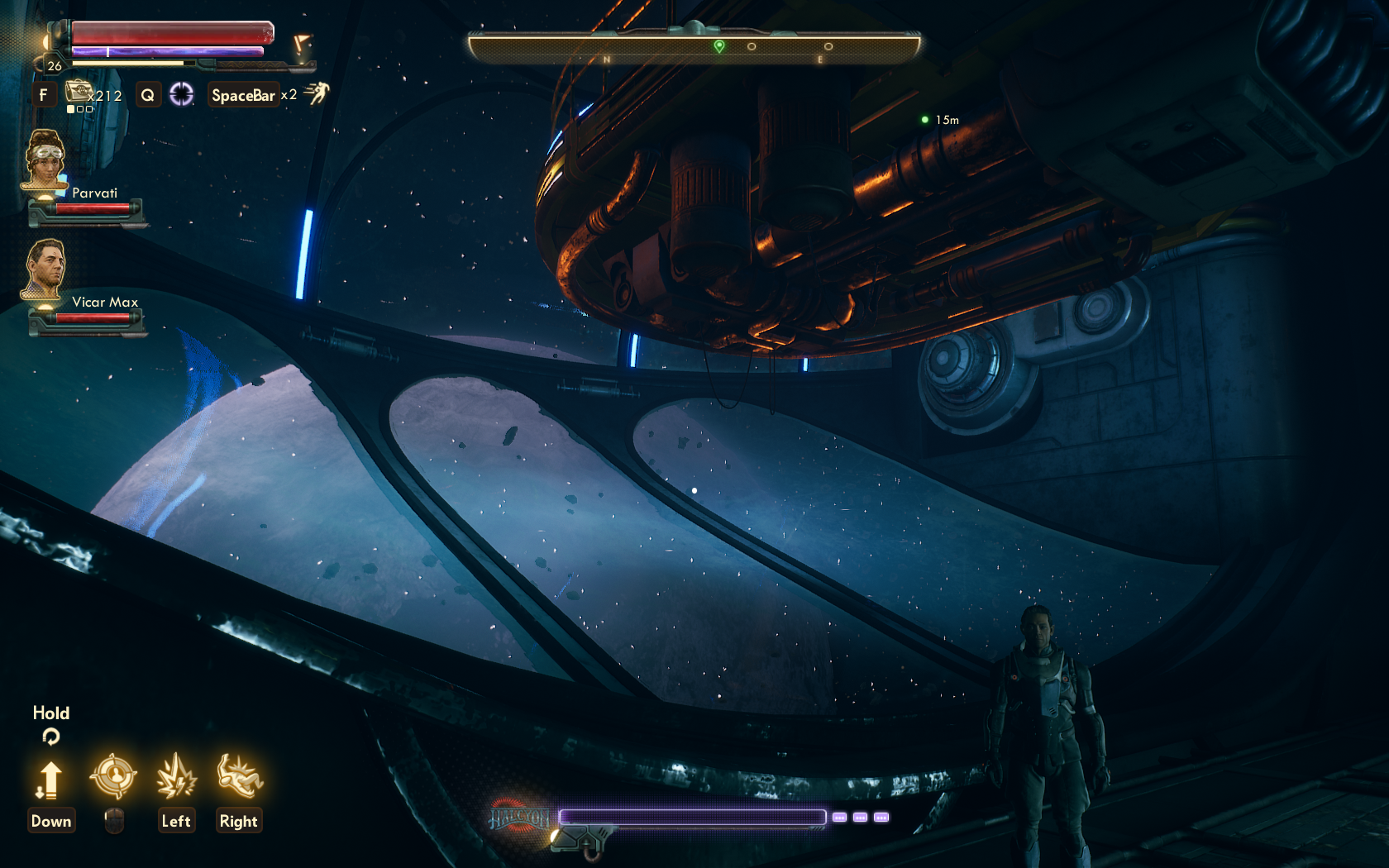
Is it PC?
I will say this right off the bat, it is an absolute pleasure to play a game of this type and not have it mired in performance issues. It was a running joke that Fallout games would be all kinds of broken from day one (and usually remain that way). However, in the case of the Outer Worlds, it really does ‘just work’ (sorry Todd). The game has been built upon the Unreal Engine which is a far more stable and reliable platform than the cluster fuck that is the Creation Engine. I have been playing on a relatively old system and been very impressed with how the game has handled itself. You do see a lot of texture pop-in when you first enter some of the larger areas but after a few seconds this righted itself. The games UI and interface works really well and I had no problem using it, although I do think being able to track more that one mission at a time would be a good addition in a future patch.
The music in The Outer Worlds deserves a special mention. Justin Bell is the composer on this game and I have to say he has done a sterling job. Every piece of music in the game fits with what you are seeing on screen and interestingly my favourite is actually the music that plays on the title screen. Sound effects are all decent enough apart from the ballistic weapons being a little too tinny for my likening, I would have rather had some more meaty booms and bangs. As I have mentioned, the voice acting is mostly excellent and deserves a special nod.
Conclusion
The Outer Worlds feels like a proof of concept or an answer to the question, do people want more games like Fallout: New Vegas? There are many areas of this game I feel don’t reach the level I would have liked them to do, like the shallow combat, linear character skills and basic world systems. However, where it really counts the Outer Worlds absolutely excels and this makes those areas that are under baked far less of a problem. This is an RPG first and foremost and on this front, the team at Obsidian have delivered in spades. It is also so refreshing these days to play a game which isn’t trying to sell you microtransactions or a season pass.
It would be naive to think that Bethesda’s fall from grace hasn’t left gamers wanting The Outer Worlds to succeed all the more. I do hope that Microsoft sees how much love fans have for this new game and support a sequel of some kind. I suspect we will be boarding the Unreliable again in the future and given there are a few planets in the Halcyon system still locked, maybe an expansion is on the cards? My main hope is that if we do see an Outer Worlds 2 at some point, the systems around the fantastic dialogue choices are expanded upon. If you have been pining for the next Fallout game or love good RPG’s this is one game you shouldn’t miss.
Thank you for reading my review of the Outer Worlds on PC. It is unfortunate that the game’s publisher, Private Division, decided to make this game an Epic Exclusive. Of course, the game isn’t fully exclusive because it is also available to play on the Microsoft store and via Game Pass. I would hope that future games in this series will not support anti-consumer platforms like the Epic Game Store and let players choose where they buy their games.


